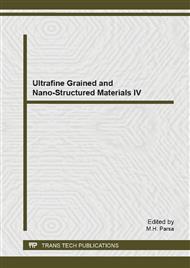p.362
p.366
p.371
p.376
p.381
p.386
p.391
p.396
p.401
Electrolytic Coloring of Anodized Aluminum by Copper
Abstract:
It is important to generate aluminum oxide layer on the surface of aluminum in order to enhance the adhesion of the dye molecules in coloring aluminum industry. One of the major advantages of aluminum is the formation of a resistant oxide layer naturally, but the thickness of this layer is not high enough and it should be damaged due to lack of mechanical strength. However, the thickness of oxide layer can be increased through anodizing; this process improves its abrasion and corrosion resistance as well as its mechanical properties. In the present study, specimens of pure aluminum were anodized under galvanostatic condition in sulfuric acid electrolyte and porous nanostructured aluminum oxide layer was formed. Porosity of the anodized layer was controlled by optimizing the working conditions such as electrolyte concentration, anodizing time and current density. Finally, the specimens were electrolytically colored by applying alternating current to copper (Cu) solutions. Colored coatings were created at constant voltage and different coloring duration. The results indicated that the shade of different metal ions can be optimized by controlling the coloring parameters, the longer time of coloring results in the darker colors. The samples were examined by X-Ray Diffraction (XRD) spectroscopy and Scanning Electron Microscopy (SEM) and electrochemical test.
Info:
Periodical:
Pages:
381-385
Citation:
Online since:
November 2013
Price:
Сopyright:
© 2014 Trans Tech Publications Ltd. All Rights Reserved
Share:
Citation:


